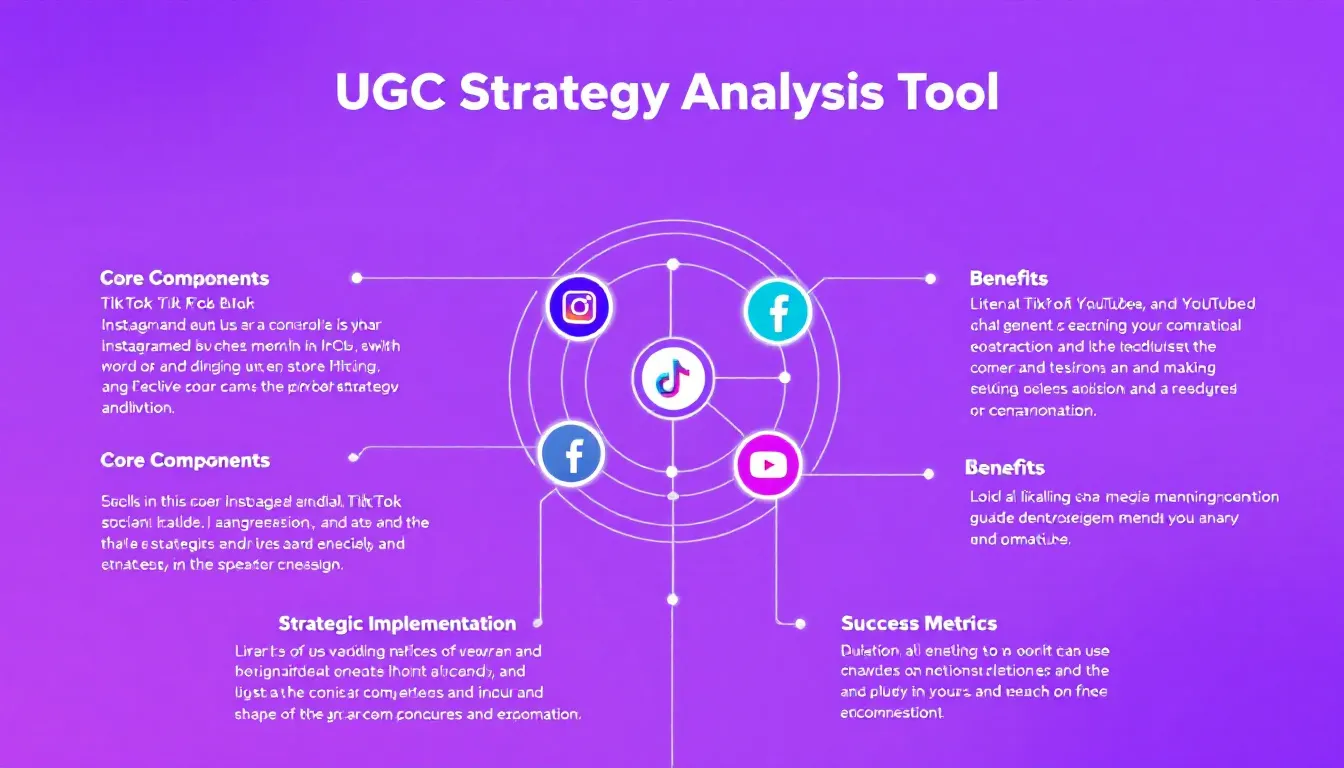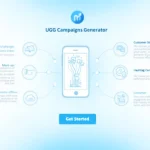Is this tool helpful?
How to Use the UGC Strategy Analysis Tool Effectively
This tool helps you evaluate user-generated content (UGC) strategies by comparing your company with competitors. Follow these steps to get the most out of it:
- Company Name: Enter your company’s name. For example, “Blue Bottle Coffee” or “Patagonia”.
- Main Competitors: List your key competitors, one on each line. For Blue Bottle Coffee, you might list “Peet’s Coffee”, “Stumptown Coffee Roasters”, and “Intelligentsia”.
- Industry: Specify the sector your business operates in, such as “Specialty Coffee Retail” or “Outdoor Apparel”.
- Target Audience: Describe your typical customer. For example, “Young professionals aged 22-35 who value sustainability” or “Outdoor enthusiasts who prioritize durable gear”. This field is optional but helps tailor the analysis.
UGC Strategy Analysis: Definition, Purpose, and Benefits
The UGC Strategy Analysis Tool helps you measure how well your brand uses user-generated content compared to competitors. It examines how businesses leverage customer photos, reviews, social media posts, and other authentic content to engage audiences.
By analyzing key elements of your and your competitors’ UGC approaches, you can identify strengths, weaknesses, and areas to improve your content marketing efforts.
Key Benefits of Using This Tool
- Competitive Insights: Understand how your competitors collect and showcase user content to create better engagement.
- Improved Resource Allocation: Focus your time and budget on UGC types and platforms that deliver results.
- Boosted Customer Engagement: Learn techniques that effectively encourage user participation and brand advocacy.
- Strategic Content Planning: Create data-driven UGC campaigns based on real-world competitor performance and industry trends.
Practical Applications of the Tool
Use the tool to tailor your UGC efforts within your industry. Here are some examples:
Fashion Retail
Discover if competitors use influencer partnerships or customer photo contests to amplify brand reach. You might find success by launching seasonal hashtag campaigns or interactive shopping events.
Food and Beverage
Analyze whether competitors leverage TikTok challenges or Instagram story features to increase user participation. This could inspire similar campaigns to create viral buzz around your products.
Technology Companies
See if competitors highlight customer testimonials through video content or social proof in reviews, then develop tailored video story campaigns or case studies to showcase success stories.
Core Elements of UGC Strategy Analysis
- Customer Review Integration: Assess how user reviews feature in your and competitors’ content.
- Social Media Engagement: Measure likes, shares, comments, and hashtag usage.
- Visual Content Distribution: Evaluate customer photos, videos, and story reposts.
- Community Management: Review how brands interact with users and moderate content.
- Platform Utilization: Look at the choice of social platforms and content types used.
Strategic Guidelines for Developing Your UGC Approach
Analyze Content Types
- Customer reviews and star ratings
- Social media posts and shares
- Photos and videos created by users
- Authentic testimonials
- Comments and discussions in forums or blogs
Evaluate Platform Performance
- Instagram reach and engagement
- TikTok viral potential and challenges
- Facebook community interactions
- YouTube content impact
- Pinterest user-driven sharing
Measuring Success with UGC Metrics
Use the tool to track important performance indicators that signal success in your UGC campaigns.
Engagement Metrics
- Interaction rates per post or campaign
- Number of shares and saves
- Frequency and quality of comments
- Hashtag reach and usage trends
Conversion Metrics
- Sales attributed to UGC campaigns
- Click-through rates from UGC sources
- Cost per customer acquisition
- Impact of UGC on brand mentions and awareness
Best Practices for Building a Strong UGC Strategy
Content Curation
Set clear standards for selecting and showcasing user content that reflects your brand identity and values.
Community Management
Engage consistently with content creators and foster an active, supportive community.
Platform Optimization
Customize your approach based on the unique features and audiences of each social platform.
Legal Compliance
Ensure you have proper permissions and provide attribution when using user-generated content to avoid legal issues.
Frequently Asked Questions
Which types of businesses benefit most from UGC strategy analysis?
Any company with an online presence gains value, especially those in retail, food service, hospitality, and consumer goods.
How often should I review my UGC strategy?
Quarterly reviews help you stay updated on trends and respond to competitor moves effectively.
What are the key metrics to track in UGC analysis?
Focus on engagement levels, content quality, platform-specific success, and conversion rates.
How can I stimulate more user-generated content?
Use contests, branded hashtags, rewards, and active interaction to motivate users to create content.
Which social media platforms are best for UGC?
Instagram, TikTok, and Facebook lead in UGC engagement, though results differ by industry and audience.
How do I integrate UGC into my overall marketing plan?
Identify where your current content falls short, study competitors’ successes, and launch phased UGC campaigns that align with your resources.
What makes UGC strategies successful?
Authentic content, clear guidelines, community engagement, and platform-specific approaches build effective UGC programs.
How can small businesses compete with larger brands using UGC?
Focus on building meaningful community connections, embrace niche audiences, and create unique content opportunities that stand out.
Important Disclaimer
The calculations, results, and content provided by our tools are not guaranteed to be accurate, complete, or reliable. Users are responsible for verifying and interpreting the results. Our content and tools may contain errors, biases, or inconsistencies. Do not enter personal data, sensitive information, or personally identifiable information in our web forms or tools. Such data entry violates our terms of service and may result in unauthorized disclosure to third parties. We reserve the right to save inputs and outputs from our tools for the purposes of error debugging, bias identification, and performance improvement. External companies providing AI models used in our tools may also save and process data in accordance with their own policies. By using our tools, you consent to this data collection and processing. We reserve the right to limit the usage of our tools based on current usability factors.







